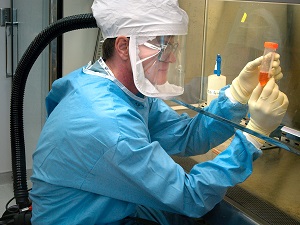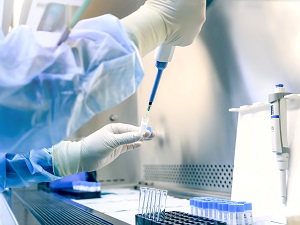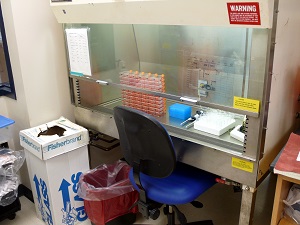Properly maintained Biosafety Cabinets (BSCs), when used in conjunction with good microbiological techniques, provide an effective containment system for safe manipulation of moderate- and high-risk infectious agents (BSL-2 and BSL-3).

BSCs protect laboratory workers and the immediate lab environment from infectious aerosols generated within the cabinet.
Required Personal Protective Equipment (PPE)
Lab workers utilizing the biosafety cabinet should wear appropriate personal protective equipment (PPE). Lab coats must be buttoned or closed in the back if tied for greater protection. Gloves should be pulled over the wrists of lab coats, not worn inside the sleeve.
OSHA Standard 1910.1030(e)(2)(iii)(A) Certified biological safety cabinets (Class I, II, or III) or other appropriate combinations of personal protection or physical containment devices, such as special protective clothing, respirators, centrifuge safety cups, sealed centrifuge rotors, and containment caging for animals, shall be used for all activities with other potentially infectious materials that pose a threat of exposure to droplets, splashes, spills, or aerosols.
Risk Assessment and BSC Selection
Employers should ensure that a risk assessment has been completed and approved for the work to be conducted and to identify the class and type of BSC needed for the operation or procedure.

Before Using a Biosafety Cabinet
Before using any biosafety cabinet (BSC), lab workers should:
- Prepare a written checklist of materials necessary for a particular activity and place only necessary materials in the BSC before beginning work.
- Turn off any overhead room germicidal ultraviolet light (UV) and any BSC UV lights.
- Confirm that the BSC is currently certified for use.
- Confirm that the BSC is operating properly prior to beginning work by checking airflow gauges.
- Adjust the stool height so that armpits are level with the bottom of the view screen or sash.
OSHA Standard 1910.1030(e)(2)(iii)(B) Biological safety cabinets shall be certified when installed, whenever they are moved and at least annually.
Only materials and equipment needed for the immediate work should be placed in the biosafety cabinet. Store extra supplies outside the BSC.
Do not use equipment or store supplies inside the BSC that may disrupt the protective BSC airflow pattern. If large equipment must be placed inside the BSC, place it as far back in the BSC as practical.

Minimizing Airflow Disruptions
To minimize frequent in and out arm movement and maintain the air barrier, do not tape autoclavable biohazard collection bags to the outside of the biosafety cabinet. Upright pipette collection containers should not be used in the BSC or placed on the floor outside the BSC. Instead, horizontal discard trays containing an appropriate chemical disinfectant should be used.
Move arms in and out of the cabinet slowly, perpendicular to the face opening, to limit disruption of the air curtain. Manipulation of materials inside the cabinet should be delayed for 1 minute after placing hands and arms inside the cabinet to allow the air to stabilize and to “air sweep” arms.
Do not rest arms on front grille (unless the BSC is specifically equipped with features that permit this action) because doing so allows room air to flow directly into the work area rather than being drawn through the front grille. Instead, work with both arms raised slightly.
Safe Handling of Liquids and Waste
Aspirator bottles or suction flasks should be connected to an overflow collection plastic flask containing an appropriate disinfectant, and to an in-line HEPA filter and located in the back corner of the biosafety cabinet.

Perform all operations on the work surface of the biosafety cabinet at least 4 inches from the front grille. Do not block the front grille with papers or other materials.
Make sure that active work flows from the clean to contaminated area across the work surface. Allow cabinet blowers to operate for at least 3 to 5 minutes before beginning work to allow the BSC to “purge” particulates.
OSHA Standard 1910.1030(e)(2)(ii)(E) All activities involving other potentially infectious materials shall be conducted in biological safety cabinets or other physical-containment devices within the containment module. No work with these other potentially infectious materials shall be conducted on the open bench.
Preventing Aerosols and Splashes
To reduce splatter and aerosol generation do not hold open bottles or tubes in a vertical position. Hold the lid above open sterile surfaces to minimize direct impact of downward air.
Open flames should not be used, unless absolutely necessary, because they create turbulence that disrupts the pattern of air supplied to the work surface. If an open flame is necessary, use a touch plate microburners that can provide a flame on demand or an electric furnace and make sure they are placed in the back third of the BSC. All flames must be turned off before disinfectants are used.

Handling Spills and Decontamination Procedures
If necessary, use plastic-backed absorbent toweling on the work surface, but not on the front grille, to aid in cleanup and spill containment. If spilled liquid enters through the front or rear grilles, close the drain valves and pour decontaminating solution into the drain pans. Use the appropriate decontamination solution and contact time for the pathogens used in the BSC.
Carefully handle the paper towels used for cleanup, as any materials present in the catch basin that are caught in the exhaust plenum may require BSC decontamination and the cabinet body being opened to remove the object.
Cleaning and Shutdown Procedures
Immediately following the manipulation of infectious agents in the BSC, decontaminate surfaces and the BSC contents with the appropriate solution and contact time necessary for the infectious agents being used. Do not allow any potential contamination on the interior surfaces to remain until the end of the work shift as this will reduce the efficiency of decontamination procedures.
When work is finished, surface decontaminate all items that are to be brought out of the BSC prior to their removal. After removal of these items, the interior walls and the interior surface of the window should be wiped with 70% ethanol or other appropriate disinfectant.
At the end of the workday, surface decontaminate the BSC with 70% ethanol or dilute bleach.


.jpg)
